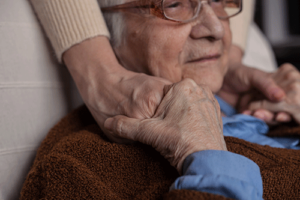 Not long ago, it was common for family members to care for aging loved ones at home. Many extended families experienced the journey of aging and death together. Nursing homes and hospitals took on a greater share of end-of-life care until people began to embrace hospice in the 1970s. Today, as more Americans transition to in-home hospice, families may once again experience the challenges and mysteries of death. While every end-of-life journey is unique, understanding some common signs of the end of life, as well as solutions to ease difficulties, can help to make the transition as comfortable and peaceful as possible.
Not long ago, it was common for family members to care for aging loved ones at home. Many extended families experienced the journey of aging and death together. Nursing homes and hospitals took on a greater share of end-of-life care until people began to embrace hospice in the 1970s. Today, as more Americans transition to in-home hospice, families may once again experience the challenges and mysteries of death. While every end-of-life journey is unique, understanding some common signs of the end of life, as well as solutions to ease difficulties, can help to make the transition as comfortable and peaceful as possible.
For compassionate hospice care, reach out to Compassus today. Our locations across 30 states offer end-of-life care that can provide comfort, pain management, and other services to individuals in their last stages of life. If you have questions, we invite you to reach out to our team at 833.380.9583.
Common End-of-Life Signs
Breathing Difficulties
Patients may go long periods without breathing, followed by quick breaths. Labored or congested breathing is common in the final days of life. You may hear the terms dyspnea or air hunger for labored breathing. Air hunger can be distressing for family members and scary for hospice patients. That breathing anxiety in patients can amplify air hunger and start a downward cycle of distress.
Solutions
Your doctor may prescribe oxygen or increase oxygen levels. Morphine is often used during end-of-life care to manage breathing problems because it dilates vessels in the lungs, allowing deeper breaths. Other strategies that can help include:
- Repositioning the patient
- Vaporizers
- Relaxation techniques
- A breeze from a fan or window
Most hospice caregivers have experience with reducing breathing problems.
Drop in Body Temperature and Blood Pressure
Body temperature can go down by a degree or more as death nears. Blood pressure will also decrease, contributing to reduced blood flow to the hands, feet, nose, and lips. You may notice the patient’s skin turning pale, bluish, or mottled. Some people may fluctuate between being hot and cold.
Solutions
Use soft blankets to keep loved ones warm. Don’t use electric blankets because patients in end-of-life stages often cannot tell you it’s too hot. A cool cloth on the forehead or a fan can comfort those who feel hot.
Less Desire for Food or Drink
Hospice patients may want to eat but experience difficulty swallowing or nausea. Medications and diseases can also change the taste of food.
Food is often associated with nurturing and keeping up strength. For many people who are exhibiting end-of-life signs, food can cause stomach and digestive problems. Avoid forced or pressured eating by allowing loved ones to eat softened versions of food when they want it. As the body transitions to active dying, it often signals it has less need for food.
“The issue of nutrition is probably one of the most guilt-inducing and emotionally charged issues for patients and families. There will come a time when a patient no longer feels any desire to eat. No matter how upsetting to the family, the patient should not be pressured or forced into eating.”
– Synthia Cathcart, RN, BSN
Solutions
Offer small meals to those who still have the desire to eat. Serve meals during a time when patients experience less pain or agitation. Travel mugs with a straw enable patients to drink on their own schedule. If someone is refusing food or drink, flavored or plain ice chips can keep the mouth moist.
Changes in Sleeping Patterns
Your loved one may significantly increase the hours they sleep. This is a normal result of having less energy and eating less. Some hospice patients may be restless, agitated, or make repetitive motions.
Solutions
Allow your loved one to sleep. Your doctor may prescribe medications to reduce pain or anxiety.
Confusion or Withdrawal from Others
State of mind is different for every person approaching death. Hallucinations, confusion, and reduced responsiveness are common near the end of life.
Solutions
Keep talking to your loved one. Even if they don’t respond, they may still be able to hear you. Soft background music, dimmed lights, and calming scents can be relaxing. Identify yourself when talking and continue to touch and stay close to your loved one.
Find Compassionate End-of-Life Care from Compassus
Compassus offers a full range of end-of-life care options. From hospice to palliative care, our team of compassionate healthcare professionals will work with you to provide personalized end-of-life services. Our goal is to help your loved one feel at peace and supported during the final stages of life. Contact us today at 833.380.9583 to learn more about our services or find a location near you.



